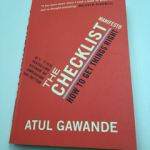The Checklist Manifesto – How to Get Things Right
By Atul Gawande

The Checklist Manifesto is not a book for the faint of heart – written in riveting and elegant prose, American surgeon Atul Gawande describes in minute detail tales of real-life operations on the human body to illustrate the motivation behind his search for the ultimate surgical checklist. The book is an adventure; a tale of derring-do and trial and error in the often resistant workplace of the medical operating theatre, and with astonishing insights into and stories from other professional disciplines, notably aviation, building and finance.
Gawande begins his journey analysing the nature of extreme complexity which he sees daily in his profession, as patients undergoing surgery are subject to human error at every step of their procedure. He describes how the World Health Organisation has now identified some 13,000 diseases, syndromes and types of injury (in other words, more than 13,000 different ways the human body can fail). In response to this, modern medicine provides clinicians with 6,000+ drugs, and over 4,000 medical and surgical procedures.
Looking at detailed cases of how this knowledge and expertise is put into practice with varying degrees of success, he concludes that the medical community’s response – to specialise, and then super-specialise in various disciplines – is no longer enough. Not only that, but it is too easy for professionals to think they consistently follow measures, where in reality, in the rare cases when they are observed objectively, they don’t. 21st century medicine has, in effect, become a minefield of unmanageable know-how and Gawande sets out to develop a strategy to provide a more consistent level of patient care.
In an Intensive Care Unit, the average patient is subject to 178 individual actions from clinicians every single day. Amazingly, the professionals administering the 178 interactions average an error rate of only 1% i.e. two per patient per day. But errors can be catastrophic, and in the operating theatres of America there are three times as many deaths following surgery than there are from road traffic accidents. Gawande is surprised at how few professionals are prepared to admit to forgetting the most basic steps while under duress and distraction, and yet things are missed all the time. For inspiration and guidance, Gawande turns to other industries facing similar levels of complexity to see what processes might be of use to further eliminate error.
Gawande begins with and returns to aviation as a shining example of the development of checklists. With a humility he evidently hasn’t seen much of in his profession, he describes how pilots “learn from the beginning of flight school that their memory and judgement are unreliable and that lives depend on their recognising that fact”. Not only this, but since pre-flight checklists began to be developed by pilots in the 1930’s, the checklists have time and again proved their worth so pilots have no reason not to trust them and what’s more, understand from the outset that the discipline of using checklists in both normal and extra-ordinary circumstances is par for the course. While the aviation industry becomes ever more sophisticated, the checklists continue to be worked over and simplified, saving lives in the process. In simple terms, checklists get the dumb stuff out of the way, freeing up your brain for the hard stuff.
The building industry has also embraced the idea of checklists in managing vast projects involving up-to–the-minute techniques and research, and co-ordinating the army of 16 types of architects, engineers and tradesmen who work on any given building. With the advent of technology, the building process has evolved from a “Master Builder” controlling every detail of the task, to the acceptance that no one person is able to have a complete mastery of everything. The “true complexity” of today’s great building projects means that “the knowledge required exceeds that of any individual, and unpredictability reigns”.
The builders follow the basic principle of a good working checklist system: the checklist (in this case the construction schedule) is balanced by communication. The latter in this case is another checklist, where a structure is in place for representatives from all parts of the building process to regularly check in with each other on any issues that arise. This focus on communication has the added benefit of devolving responsibility from a single person to a group of experts, so that extra-ordinary problems can be discussed and the best course of action determined. This also means that the process can accommodate both the following of protocol AND providing the freedom to follow the judgement and creativity of experts.
Armed with this information, Gawande goes back to the medical profession and sees precedence and importance in the charts which nurses originally put together for patients, to regularly record vital signs, together with small-scale testing in other areas of the profession. Getting involved with the World Health Organisation, he puts a team together to test the theory of checklists and how they might begin to change health practices across the world.
Using the aviation standard to clarify the ideal “rules” of putting a checklist together, he proposes the following:
- Include pause points – moments when the team communicates with each other, so for surgery this might include any risks or anomalies for a particular patient. Vitally, it also includes introducing the team to each other so that they behave as a team, especially in any emergency.
- Create either a:
a. “Do-confirm” list of actions (e.g. a nurse will read the list out and the other members of the team will confirm that the action has been taken) or
b. “Read-do” list of actions (e.g. a nurse will read each item and the team will complete each item as they go along)NB it is important to specify at what point in a procedure each list is read out, and a member of the team must be appointed to be responsible for it. - Content: ideally five to nine items – these must be the “killer actions” – only the essentials as otherwise people get distracted and start short-cutting. Use simple and exact wording appropriate to the profession.
- Test it in the real world.
Towards the end of the book’s journey, Gawande and his WHO team put together a trial of their surgical checklist in eight hospitals across both the developed and under-developed world. With tweaks and refinement along the way, the results were astounding: the rate of major complications after surgery fell by 36% and deaths fell by 47%. In addition, there was a direct correlation between improved teamwork through good communication, and a drop in surgical complications.
In analysing the data of this trial and his previous research, Gawande draws several conclusions. Good checklists:
- Promote excellent communication and teamwork, enabling errors to be picked up and avoided
- Are not comprehensive how-to guides, more, “quick and simple tools aimed to buttress the skills of expert professionals”
- Should be communicated properly – when should they be used, how should they be used?
- Deliver positive behavioural and cultural change
- Distribute power across a team with great results
- Improve outcomes with no increase in skill required
- Increases efficiency
- Should be constantly reviewed and refined – nothing stands still
- Can give an edge over competition, especially in hard times.
Gawande illustrates this last point by speaking with financiers and venture capitalists. He finds to his amazement that only one in eight venture capitalists uses the disciplined checklist approach (described as the “Airline Captain” model by Geoff Smart, author of Who), despite the fact that this approach has been proven to ensure success.
Sadly for Gawande, it seems that the finance world and the medical profession are not yet able to actively embrace the checklist. Are surgeons (for instance), just too controlling? Unable to give away power in their operating “theatre”? Gawande himself shows a willingness to admit mistakes and devolve power which, from his descriptions, seems to be lacking amongst his immediate profession, and therefore he is up against it trying to get his game-changing and proven checklist vision implemented. There is some success, however, and Britain, amongst other countries, has adopted his methods.
It is clearly frustrating for him that along with other professions, the field of medicine seems obsessed with great components (kit, drugs, studies), but little or no importance is placed on how these come together. He sees that, in these professions, there is a lack of willingness to study regular failures and “misses” in order to discover how to prevent them. He knows that intuitively “We know the patterns. We see the costs…” and urges us: “Try a checklist…”.
In the course of this engaging and thought-provoking book it becomes apparent that professions fall into three broad categories: those who lead the way in using checklists; those for whom some proponents use it (and as a result see improvements and have an edge over their competition); and those professions who have not considered or will not consider it. Thanks in no small part to Gawande, the medical profession is edging into the second category, and his journey shows us how checklists can be used to make fundamental changes in the way we do things, with fantastic results. Whether you embrace his ideas (perhaps you already implement checklists into your business), or turn a blind eye, is of course up to you…
![]()
